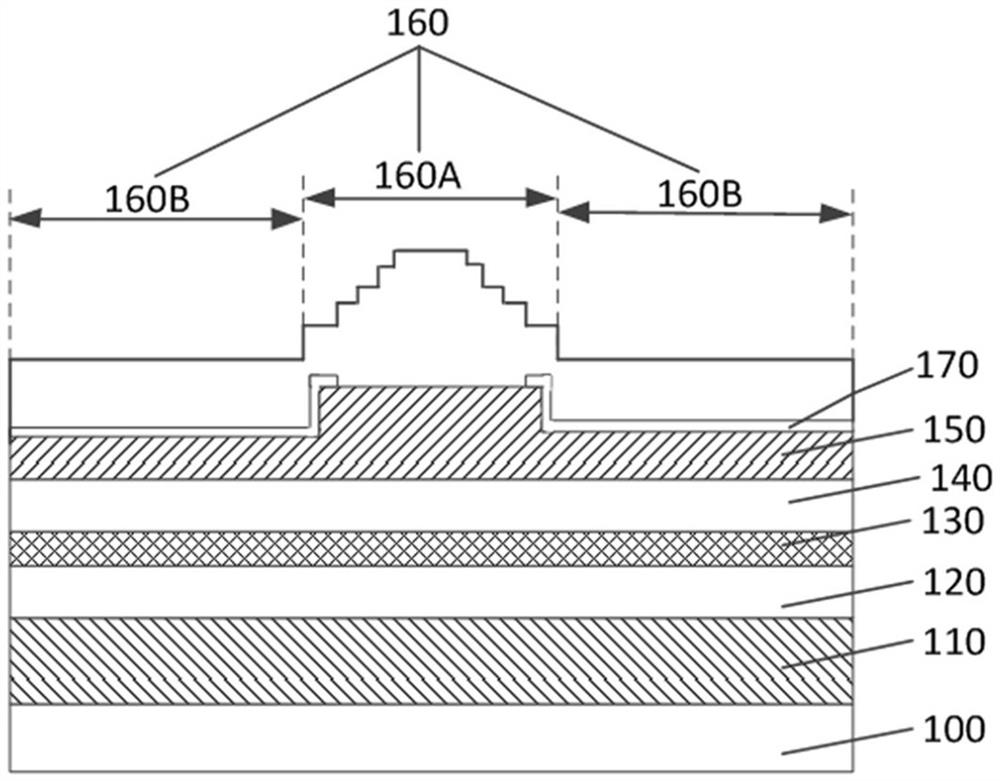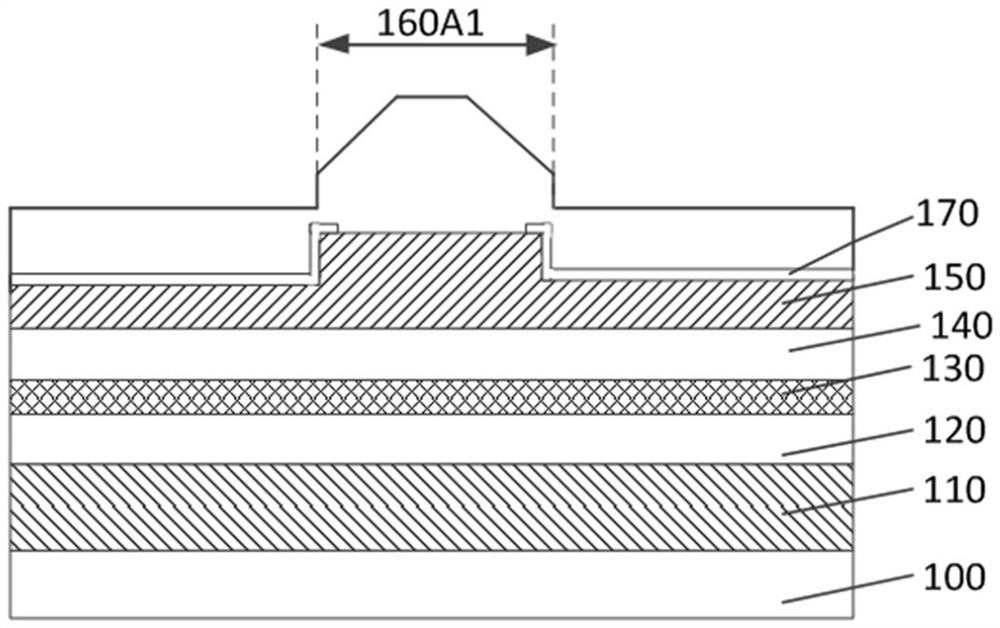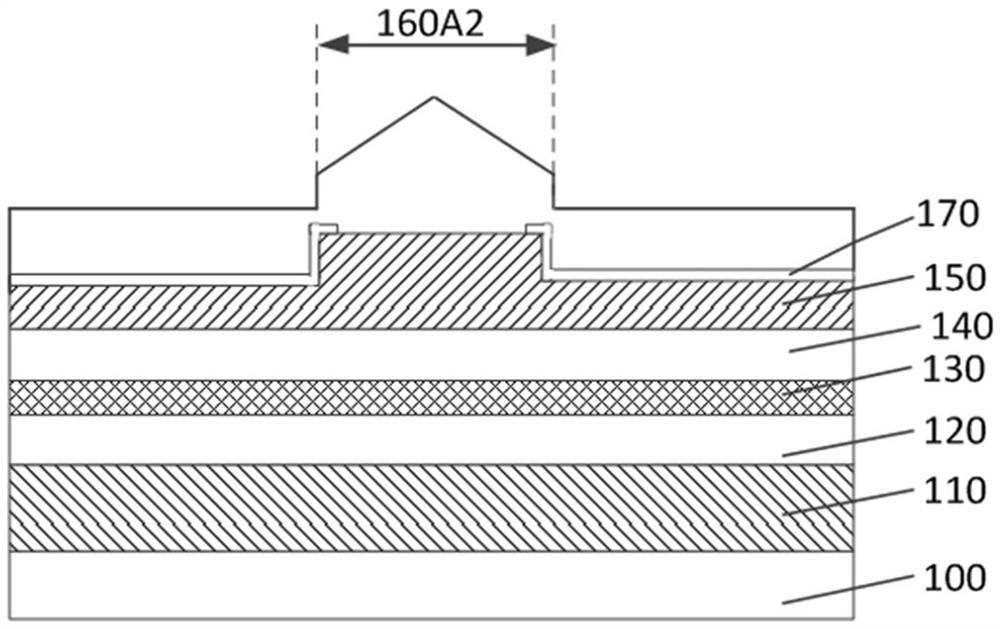Lateral light mode control high-power semiconductor device and preparation method thereof
A semiconductor, high-power technology, used in semiconductor devices, electrical components, circuits, etc., can solve the problems of high beam quality, high brightness, and high integration, and achieve the effect of improving light output brightness, reducing divergence angle, and increasing thermal conductivity.
- Summary
- Abstract
- Description
- Claims
- Application Information
AI Technical Summary
Problems solved by technology
Method used
Image
Examples
Embodiment 1
[0044] An embodiment of the present invention provides a lateral light mode control high-power semiconductor device, refer to figure 1 ,include:
[0045] semiconductor substrate layer 100;
[0046] an active layer 130 located on the semiconductor substrate layer 100;
[0047] The front electrode layer 160 located on the side of the active layer 130 away from the semiconductor substrate layer 100, the front electrode layer 160 includes an electrode injection region 160A; it is self-directed in the slow axis direction of the lateral light mode control high-power semiconductor device. The thickness of the electrode implantation region 160A decreases gradually from the central region of the electrode implantation region 160A to the edge region of the electrode implantation region 160A.
[0048] In this embodiment, the lateral light mode control high-power semiconductor device is an edge-emitting semiconductor laser.
[0049] The material of the semiconductor substrate layer 100...
Embodiment 2
[0075] The difference between this embodiment and Embodiment 1 is that: refer to Image 6 , the lateral light mode control high-power semiconductor device further includes: a thermal compensation layer 210, the thermal compensation layer 210 is located on the side of the non-injection electrode region 160B facing the active layer 130 and in contact with the non-injection electrode region 160B, the thermal compensation layer 210 The thermal conductivity of is less than that of the solder layer.
[0076] In this embodiment, since the thermal conductivity of the thermal compensation layer 210 is smaller than that of the soldering layer, the thermal conductivity of the thermal compensation layer 210 is small, which reduces the impact of the semiconductor film directly under the thermal compensation layer 210 on non-implantation The thermal conductivity of the electrode region 160B reduces the temperature gradient of the active layer 130 directly under the thermal compensation laye...
Embodiment 3
[0090] The difference between this embodiment and Embodiment 2 is: refer to Figure 7 , the thermal compensation layer 210a includes a first compensation region M1 and a second compensation region M2 arranged in the slow axis direction, and the distance from the first compensation region M1 to the electrode injection region 160A is smaller than the second compensation region M2 The distance to the electrode implantation region 160A; the thickness of the second compensation region M2 is greater than the thickness of the first compensation region M1.
[0091] against Figure 7 Thermal compensation layer, the simulation diagram of the effect is as follows Figure 8 ,and Figure 7 The structure also compares figure 1 and Image 6 By increasing the thickness of the second compensation region M2, the temperature of the active layer under the first compensation region M1 adjacent to the ridge region is further increased, and the temperature of the active layer under the first com...
PUM
| Property | Measurement | Unit |
|---|---|---|
| thickness | aaaaa | aaaaa |
| thickness | aaaaa | aaaaa |
| thickness | aaaaa | aaaaa |
Abstract
Description
Claims
Application Information
 Login to View More
Login to View More - R&D
- Intellectual Property
- Life Sciences
- Materials
- Tech Scout
- Unparalleled Data Quality
- Higher Quality Content
- 60% Fewer Hallucinations
Browse by: Latest US Patents, China's latest patents, Technical Efficacy Thesaurus, Application Domain, Technology Topic, Popular Technical Reports.
© 2025 PatSnap. All rights reserved.Legal|Privacy policy|Modern Slavery Act Transparency Statement|Sitemap|About US| Contact US: help@patsnap.com



